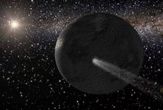
This story was updated at 2:40 p.m. EDT.
Scientists have discovered water ice on an asteroid for the second time, suggesting that it is more common on space rocks in our solar system than previously thought.
Two research teams have found evidence of water ice and organic molecules on the asteroid 65 Cybele, just six months after discovering the same stuff on a different space rock — asteroid 24 Themis — for the first time. The results suggest that asteroids may have delivered much of these essential materials for life to the early Earth, the researchers said.
"This discovery suggests that this region of our solar system contains more water ice than anticipated," said Humberto Campins, of the University of Central Florida, in a statement. "And it supports the theory that asteroids may have hit Earth and brought our planet its water and the building blocks for life to form and evolve here."
The researchers analyzed the sunlight bouncing off 65 Cybele, which has a diameter of about 180 miles (290 km), and circles the sun in the asteroid belt between the orbits of Mars and Jupiter.
The teams used two different NASA instruments: the Infrared Telescope Facility atop Mauna Kea in Hawaii, and the Spitzer Space Telescope. The telescopes picked up the telltale signatures of water ice and complex organic solids on the space rock's surface, researchers said.
The discovery of water ice on 24 Themis — announced in April 2010 by the same two research teams — changed many scientists' perspectives on asteroids. [5 Reasons to Care About Asteroids]
Sign up for the Live Science daily newsletter now
Get the world’s most fascinating discoveries delivered straight to your inbox.
Asteroid 24 Themis resides in the same region of the asteroid belt as 65 Cybele. Many scientists had thought asteroids in this part of the belt were too close to the sun to still carry water ice.
These asteroids may have been icy long ago during the solar system's youth, the thinking went, but their water should have evaporated by now.
Finding water ice on such space rocks now, 4.6 billion years after the solar system's birth, suggests that asteroids may have delivered much of the water that fills Earth's oceans — and perhaps some of the complex organic molecules that served as the building blocks of life here, scientists have said.
Earth has experienced a violent history, having been bombarded by space rocks throughout much of its life. In particular, a large rock is thought to have crashed into Earth some 4.5 billion years ago, knocking off a giant chunk of material that eventually became our moon.
At that point, the collision would have heated things up so much that any water on Earth would have been vaporized. So, how did the oceans form?
Comets hold a great deal of water ice, but they are not ideal candidates for filling up Earth's early oceans. Comet water tends to be of a different nature — its atoms are in a different configuration — than most of the water on Earth, scientists have said.
The new results strengthen the case for asteroids as water-bearers for the early Earth. In the solar system's early days, asteroids likely slammed into Earth far more frequently than they do today, researchers have said. If many asteroids were even just a little icy, the Earth could have received quite a drenching, they added.
Campins will present the team's findings today (Oct. 8) during the 42nd annual meeting of the American Astronomical Society's Division for Planetary Sciences in Pasadena, Calif.
The research has been accepted for publication in the journal Astronomy and Astrophysics.
- 5 Reasons to Care About Asteroids
- Images: Asteroids in Space
- Water Ice Discovered on Asteroid for First Time
This article was provided by SPACE.com, a sister site of LiveScience.com.

Most Popular

